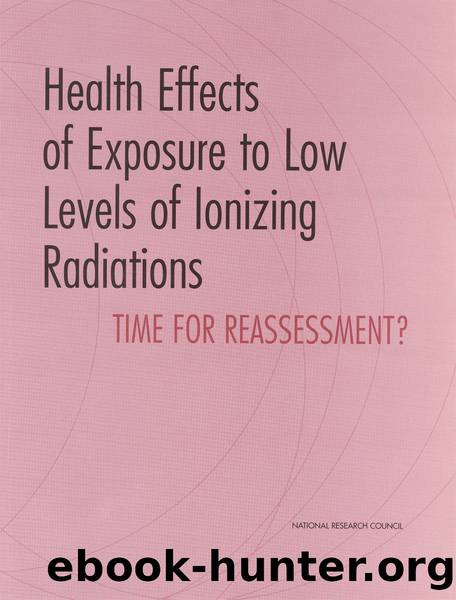Health Effects of Exposure to Low Levels of Ionizing Radiations: Time for Reassessment? by Committee on Health Effects of Exposure to Low Levels of Ionizing Radiations (BEIR VII)

Author:Committee on Health Effects of Exposure to Low Levels of Ionizing Radiations (BEIR VII)
Language: eng
Format: epub
Tags: Environment and Environmental Studies : Environmental Health and Safety
Publisher: NATIONAL ACADEMY PRESS
Published: 1998-08-04T00:00:00+00:00
If R is assumed to equal the radiation weighting factor wR. =15 that corresponds, according to the ICRP recommendations to the fission neutrons in Hiroshima, the current risk estimates are approximated, both for photons and neutrons. For larger assumed values of R, the computation provides an upper bound to the absolute risk coefficient for neutrons which would be obtained if the RBE of neutrons were infinite, that is, if the current dosimetry system (DS86) were valid and if all the excess cancer risk at Hiroshima were attributable to neutrons.
There are, in fact, more-severe restraints that exclude, with DS86, high values of R. Although not shown here, the calculations suggest, for larger values of R, there is not only a small linear component but also a vanishing quadratic component for gamma rays; this, however, is clearly inconsistent with the observations in Nagasaki, where there can be no doubt about substantial effects of the gamma rays at large doses. A combined analysis of the Hiroshima and Nagasaki data will thus be required and this will involve the consideration of added uncertainties, such as the still unresolved dosimetry of the factory workers in Nagasaki. As stated, the present exploratory computations are merely intended to indicate the general direction of the computational work that could be considered by a BEIR VII phase-2 committee.
Although the results in figure 2 must thus be seen as incomplete, they are important insofar as they indicate the inverse relation between photon and neutron risk estimates. This interrelation is disregarded in present use where the risk estimate for photons is taken to be substantially independent of the assumed RBE of neutrons and the neutron risk estimate is obtained as the product of the unchanged photon risk estimate and the assumed RBE of neutrons.
A scaling factor from excess relative risk to absolute risk has been used here that correspondsâin line with the model chosen by ICRPâto the assumption of a relative risk that does not decrease with time after exposure. More-realistic models will include such decreases and will lead to absolute risk estimates for solid-cancer mortality that are reduced by about a factor of 2 (Kellerer and Barclay 1992; UNSCEAR 1994).
Download
This site does not store any files on its server. We only index and link to content provided by other sites. Please contact the content providers to delete copyright contents if any and email us, we'll remove relevant links or contents immediately.
Whiskies Galore by Ian Buxton(41880)
Introduction to Aircraft Design (Cambridge Aerospace Series) by John P. Fielding(33064)
Rewire Your Anxious Brain by Catherine M. Pittman(18553)
Craft Beer for the Homebrewer by Michael Agnew(18140)
Cat's cradle by Kurt Vonnegut(15186)
Sapiens: A Brief History of Humankind by Yuval Noah Harari(14252)
Leonardo da Vinci by Walter Isaacson(13184)
The Tidewater Tales by John Barth(12608)
Thinking, Fast and Slow by Kahneman Daniel(12079)
Underground: A Human History of the Worlds Beneath Our Feet by Will Hunt(12024)
The Radium Girls by Kate Moore(11921)
The Art of Thinking Clearly by Rolf Dobelli(10223)
A Journey Through Charms and Defence Against the Dark Arts (Harry Potter: A Journey Throughâ¦) by Pottermore Publishing(9232)
Mindhunter: Inside the FBI's Elite Serial Crime Unit by John E. Douglas & Mark Olshaker(9201)
Tools of Titans by Timothy Ferriss(8218)
Wonder by R. J. Palacio(8010)
Turbulence by E. J. Noyes(7936)
Change Your Questions, Change Your Life by Marilee Adams(7635)
Nudge - Improving Decisions about Health, Wealth, and Happiness by Thaler Sunstein(7615)
